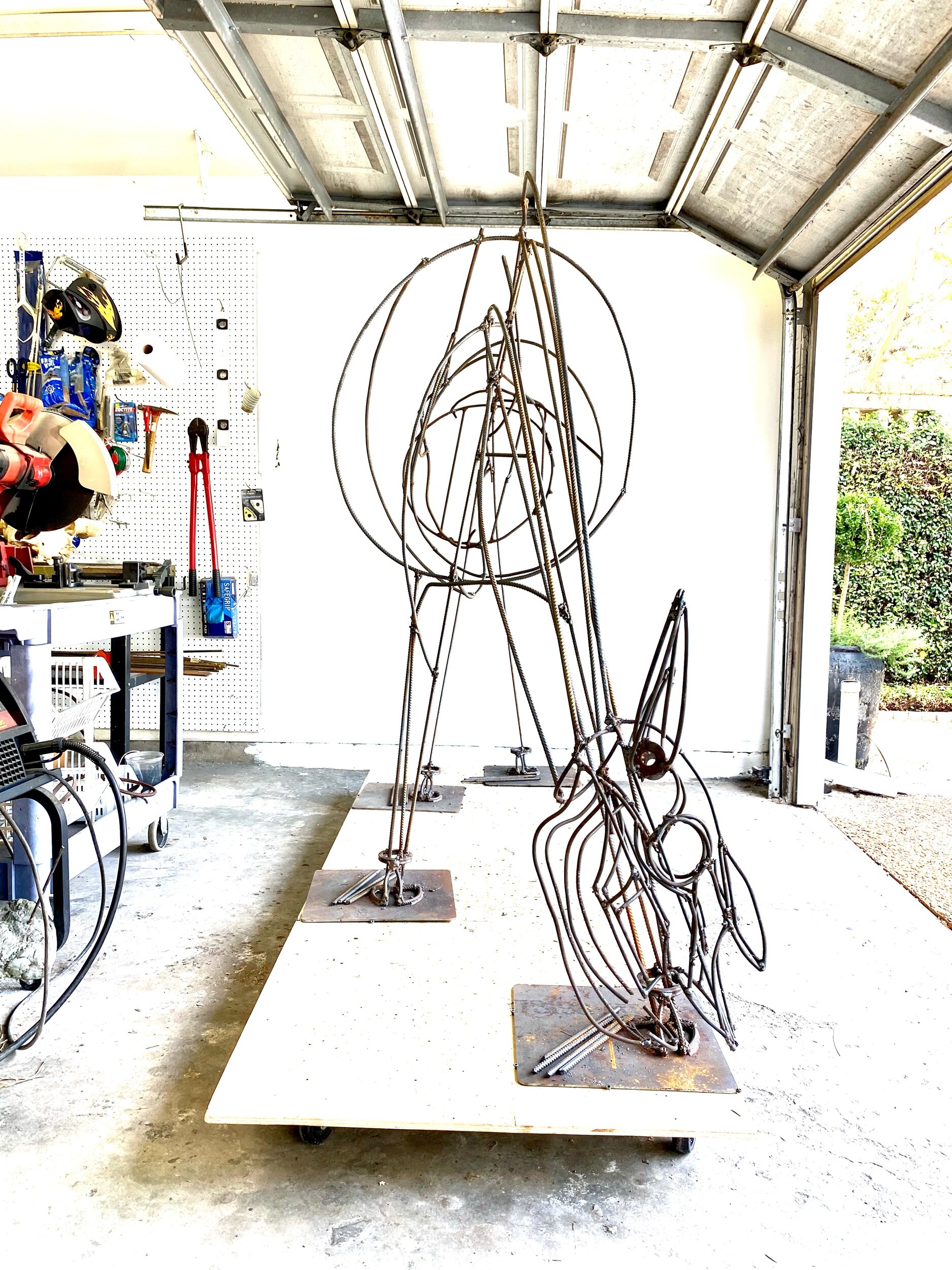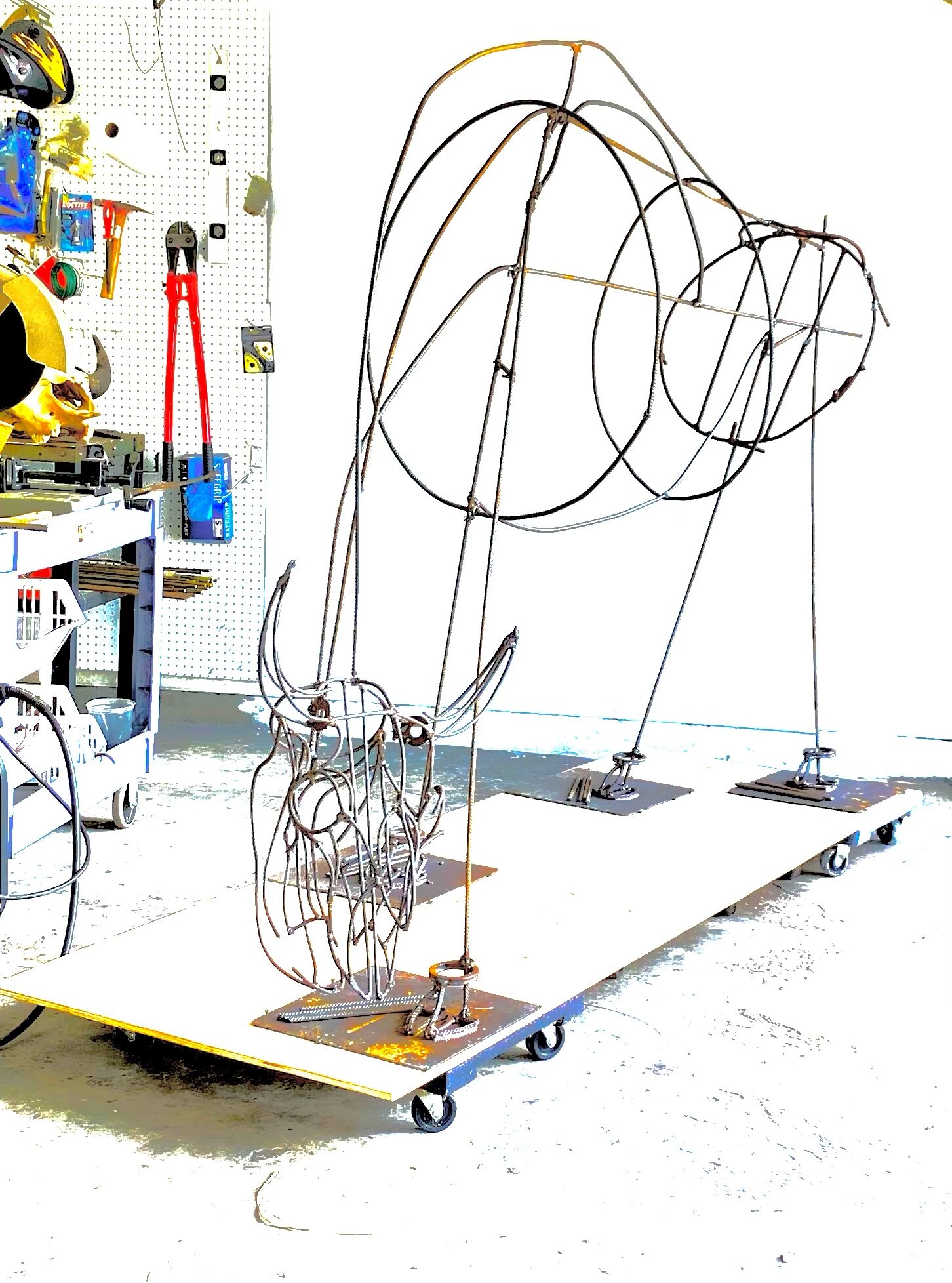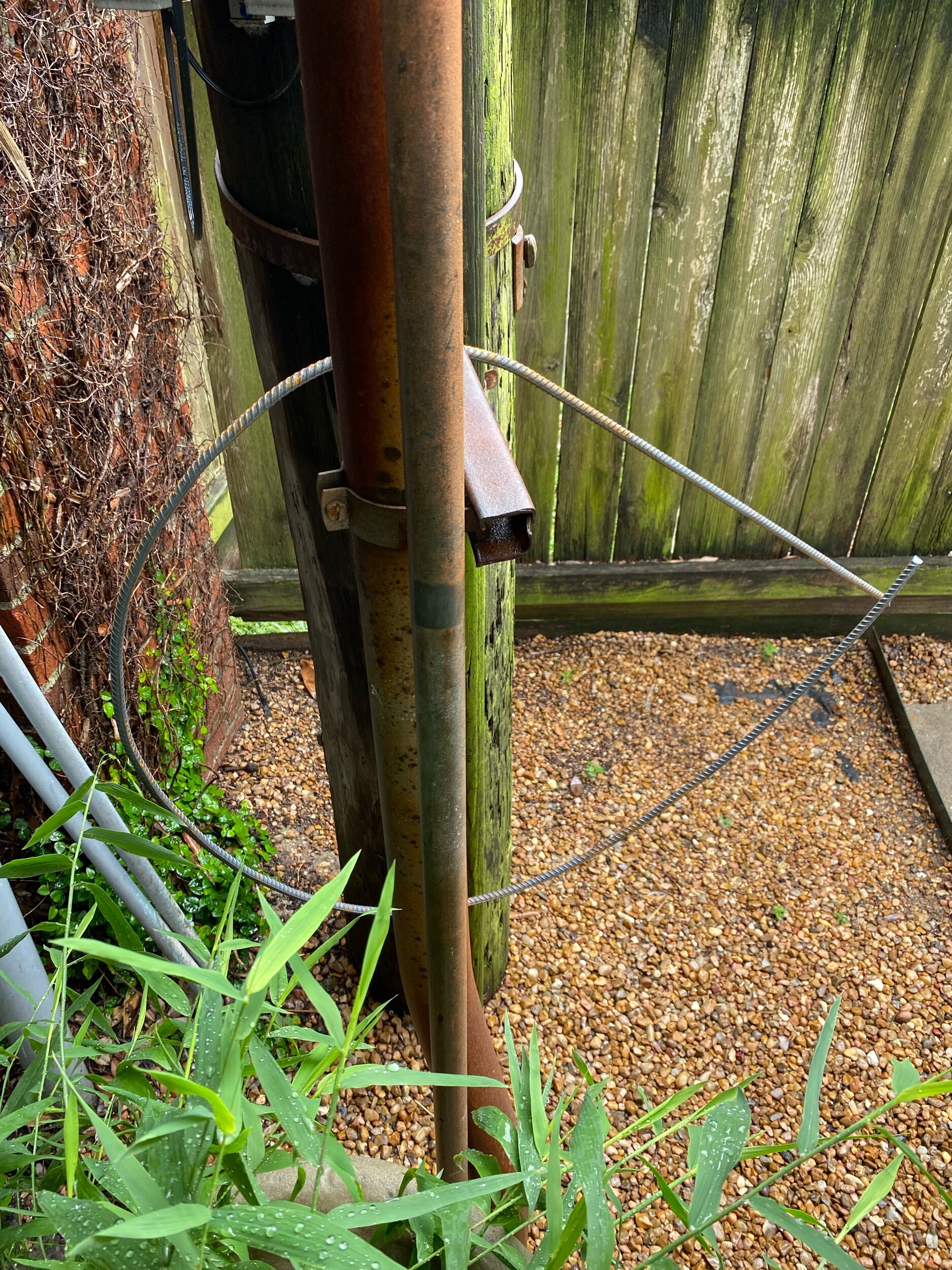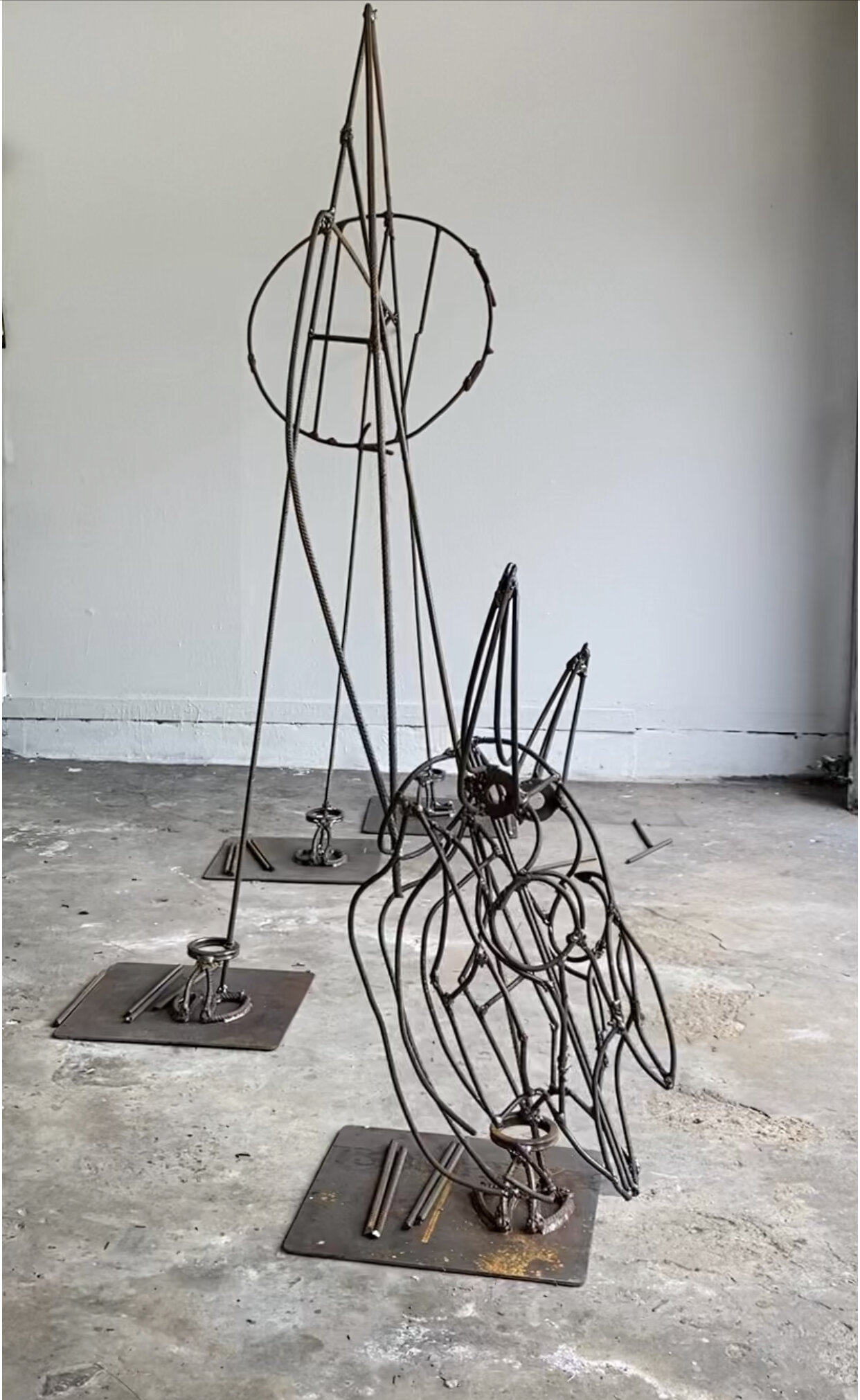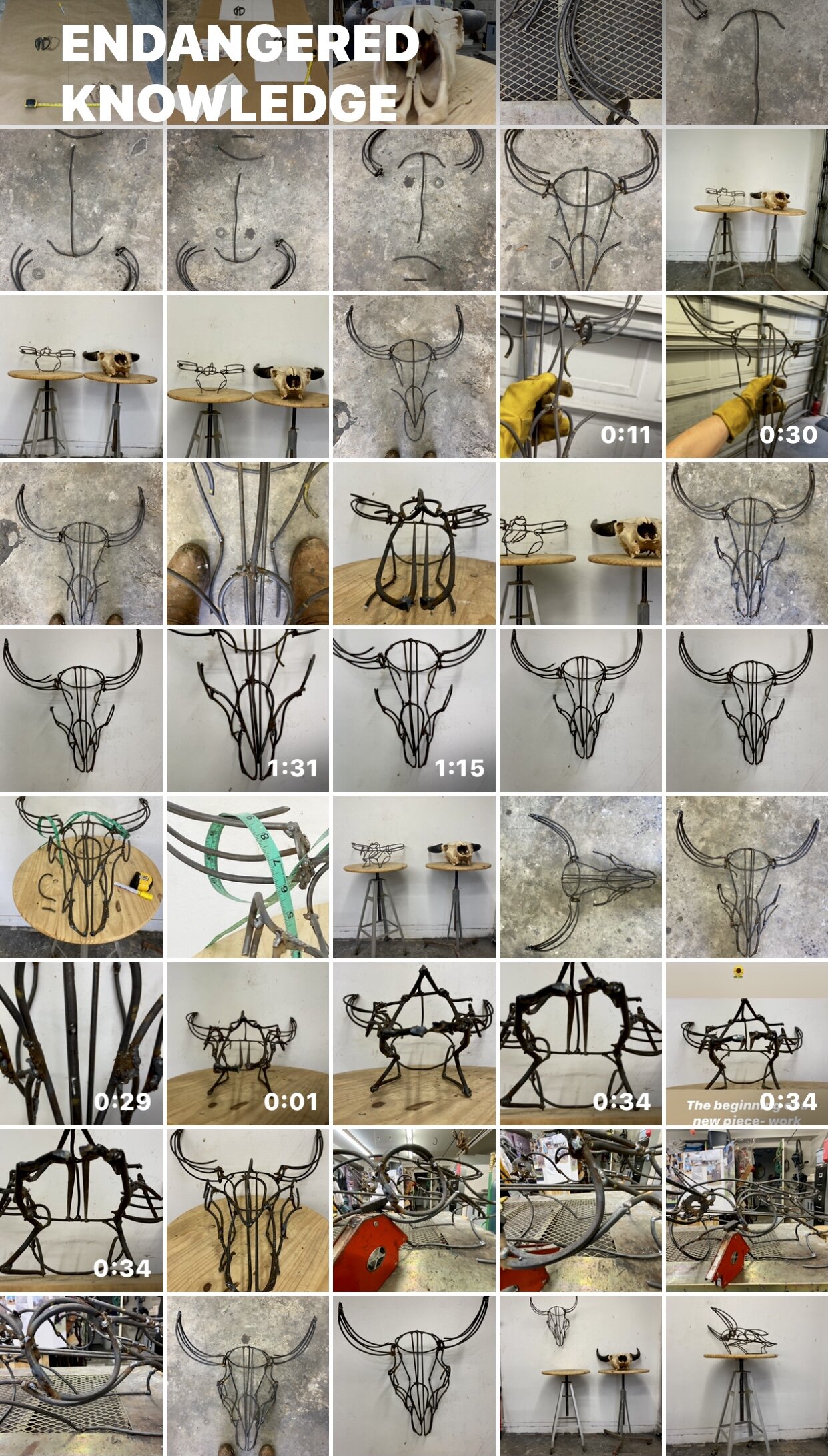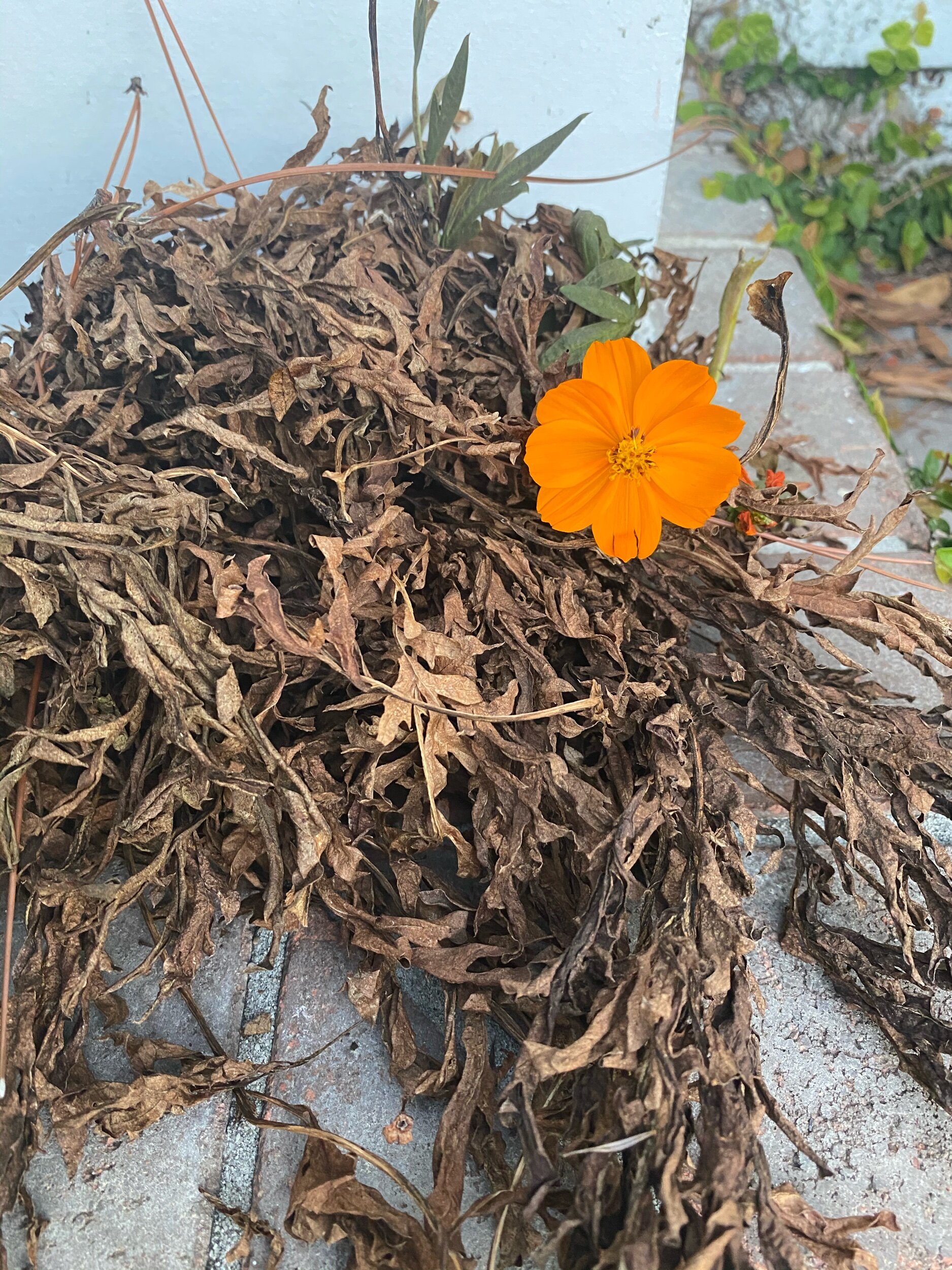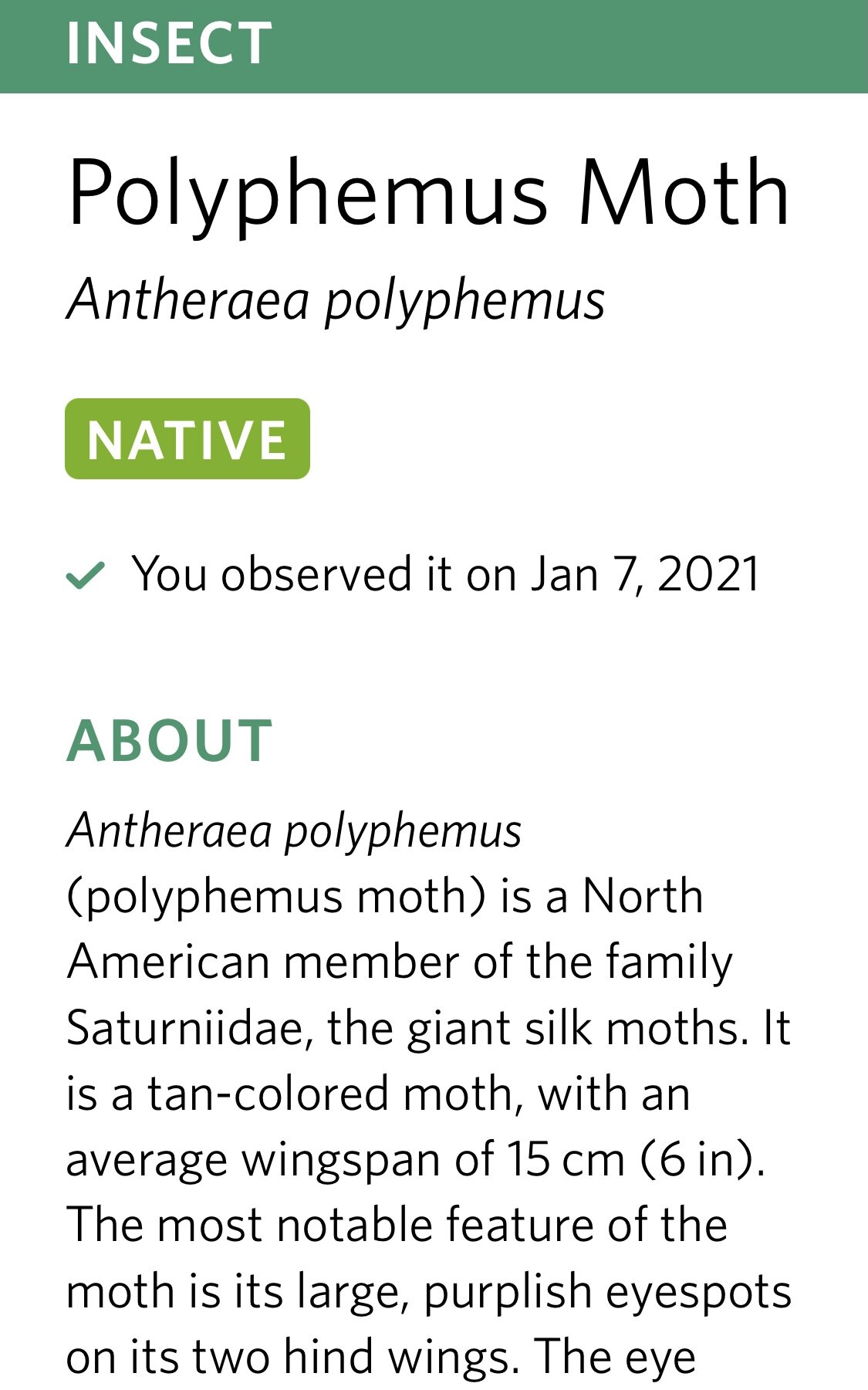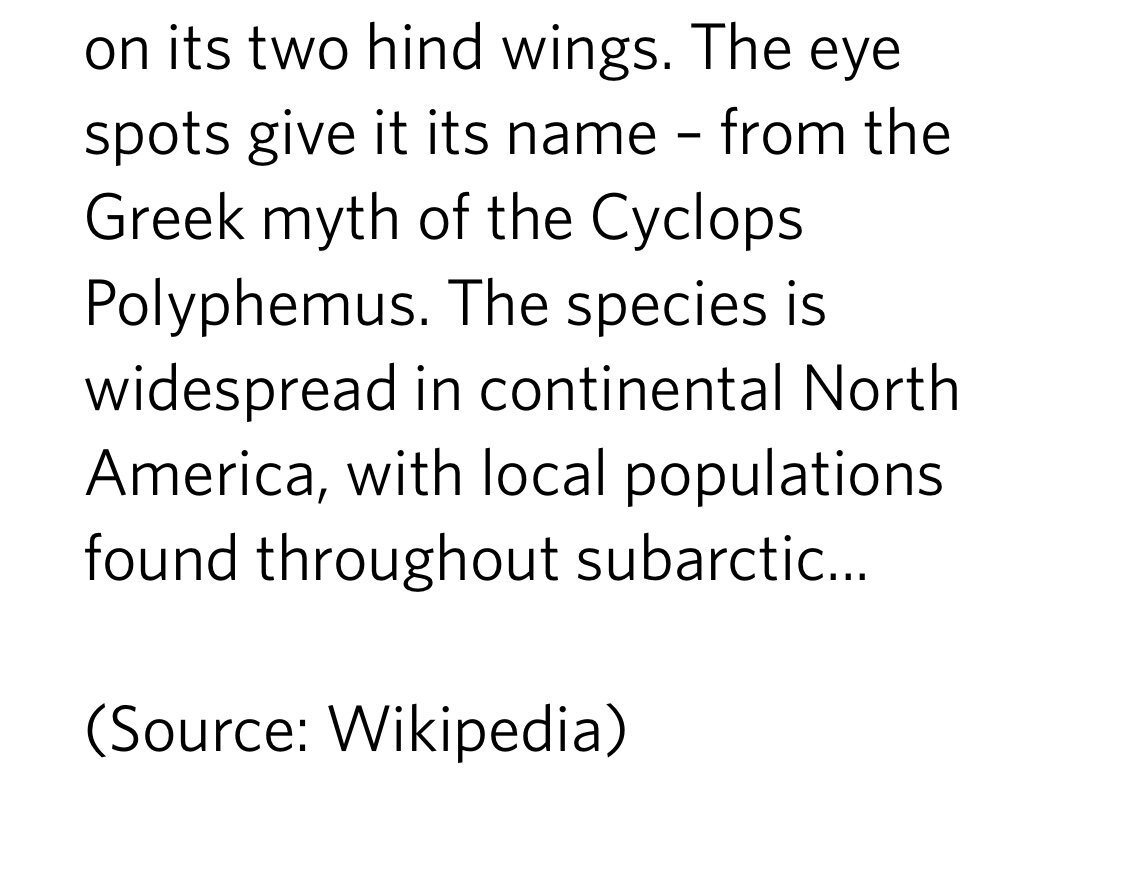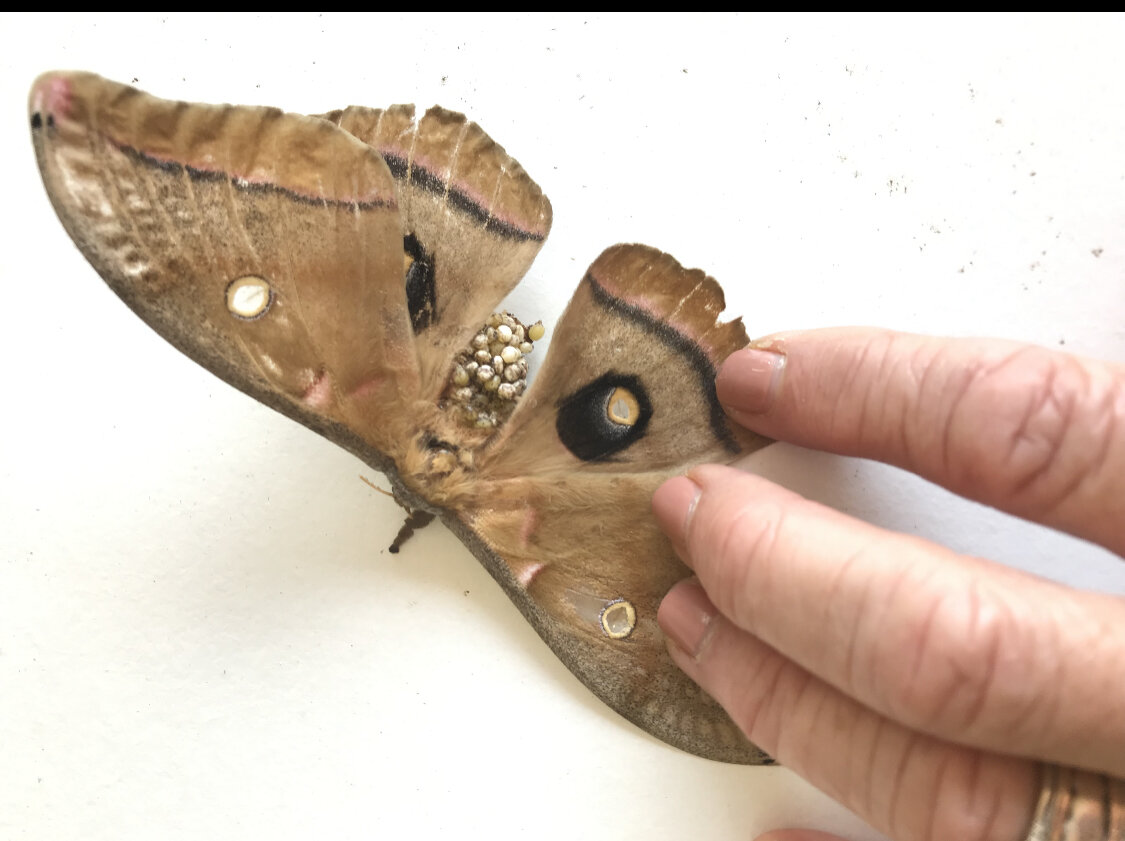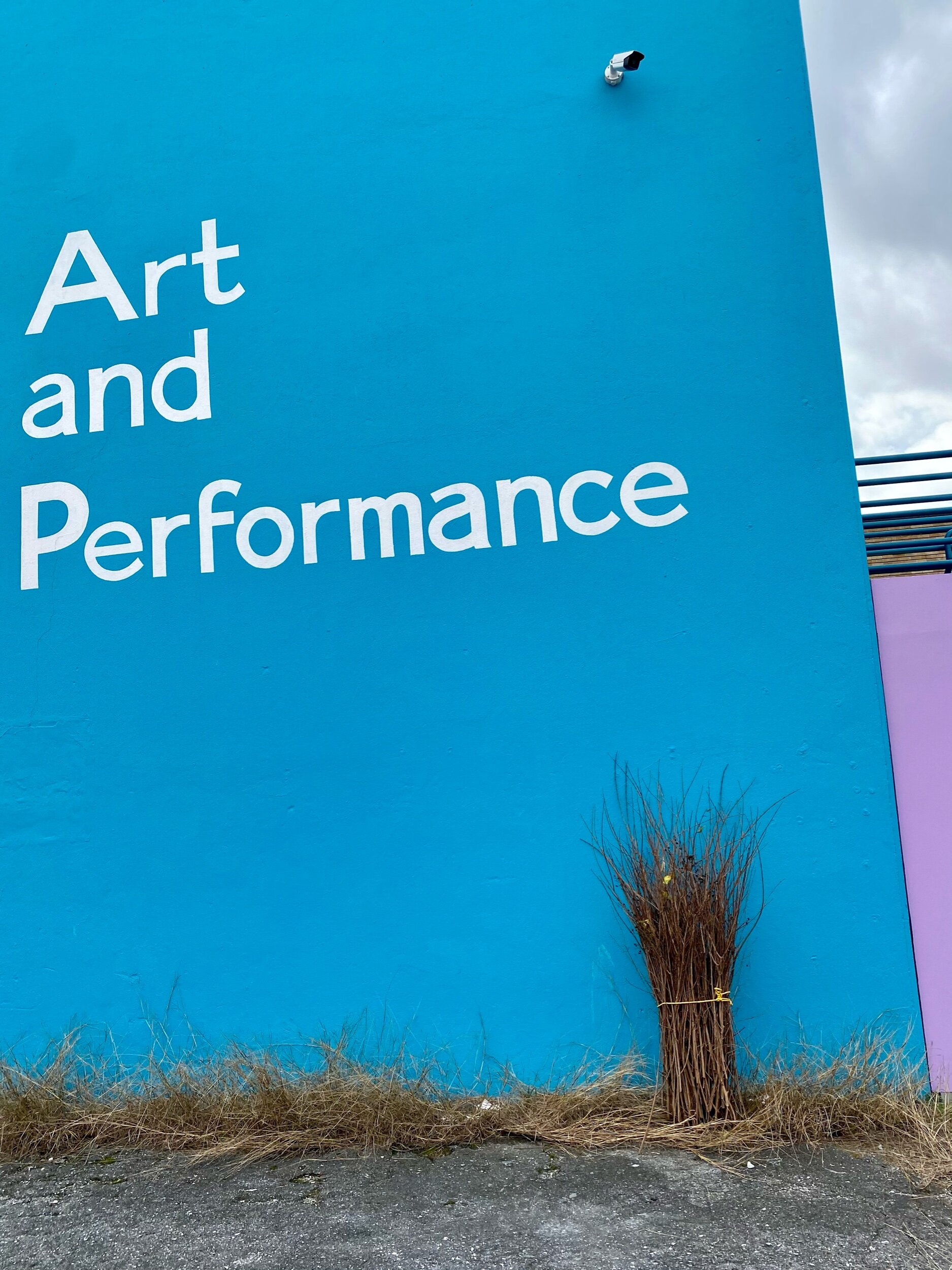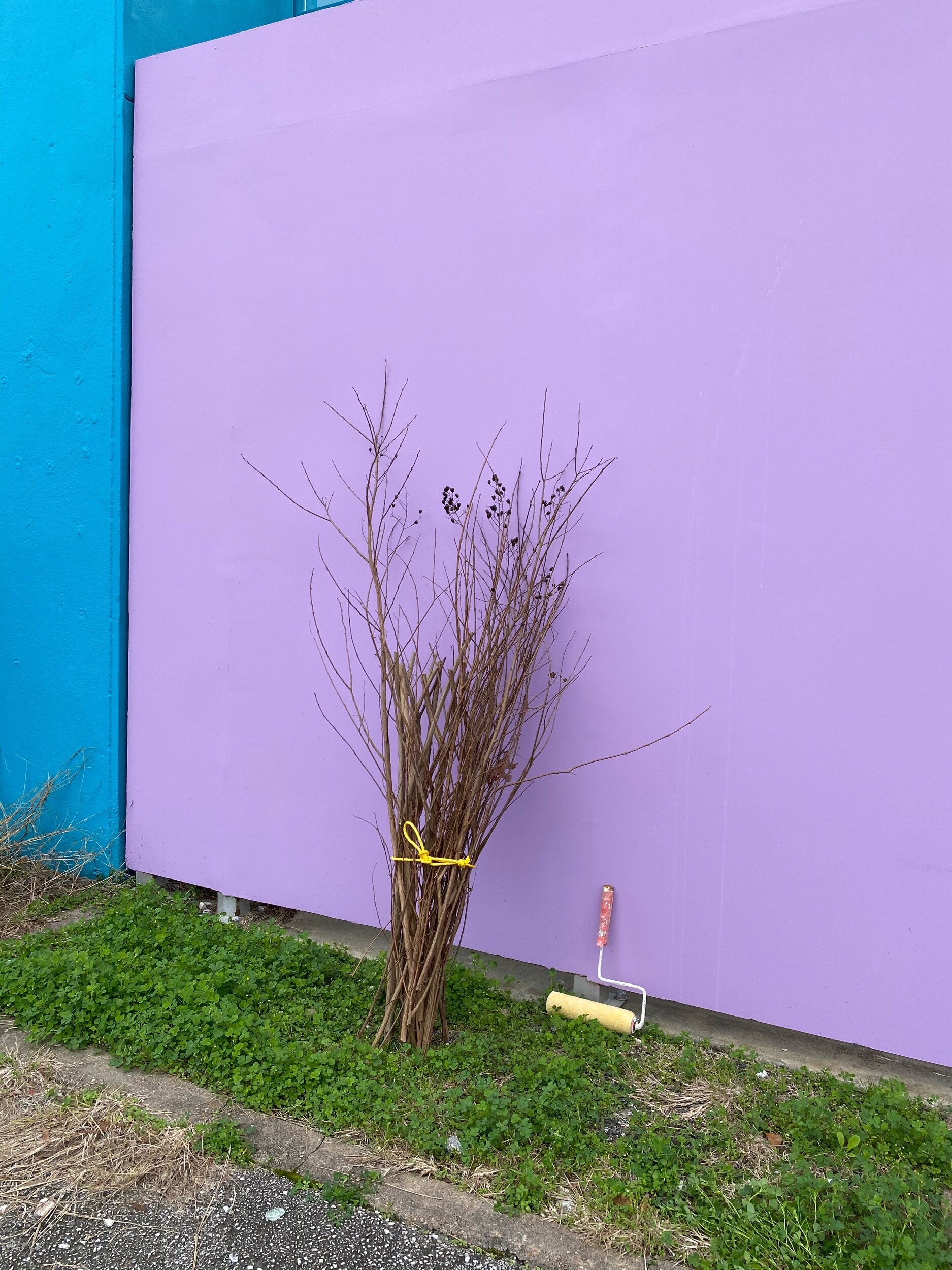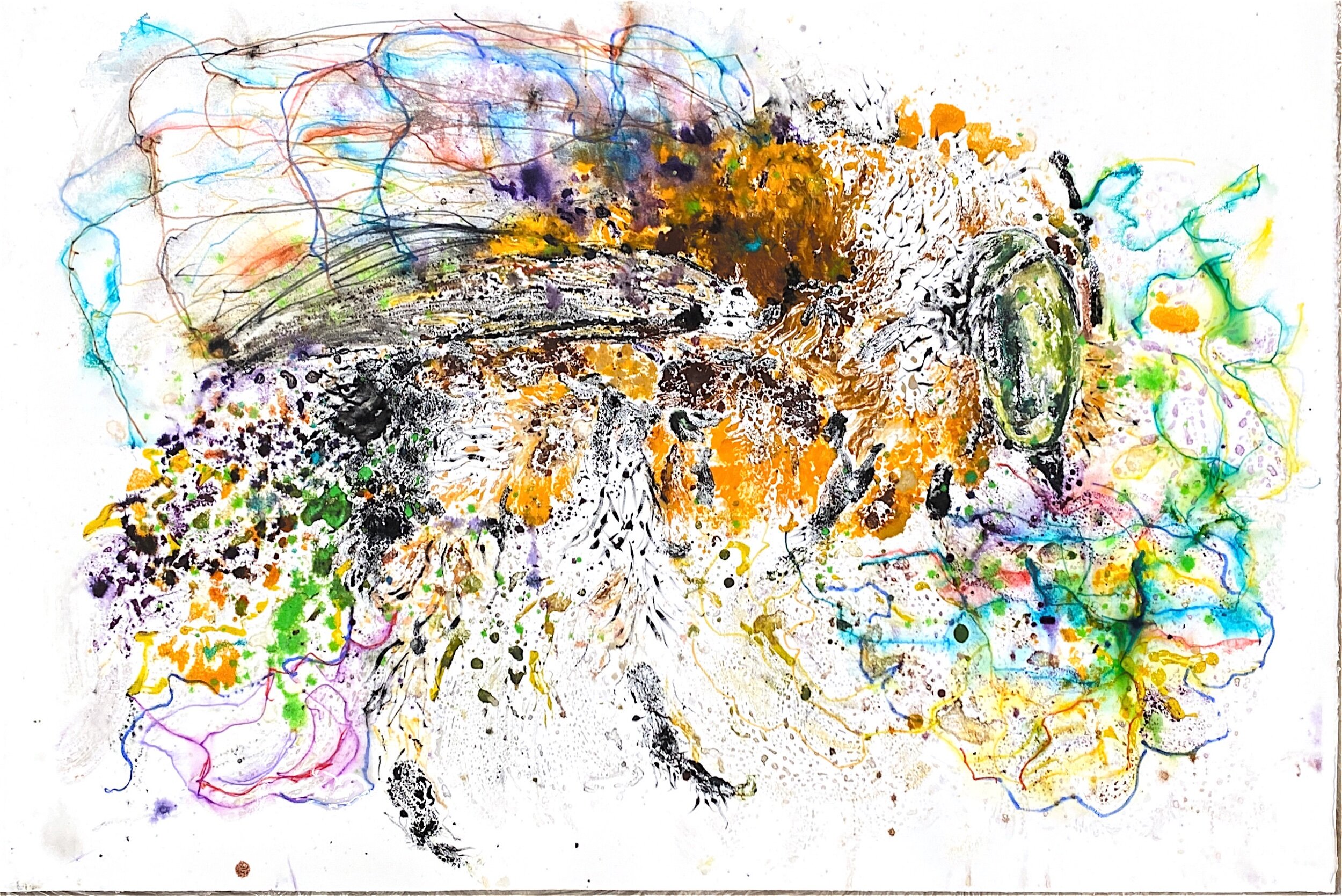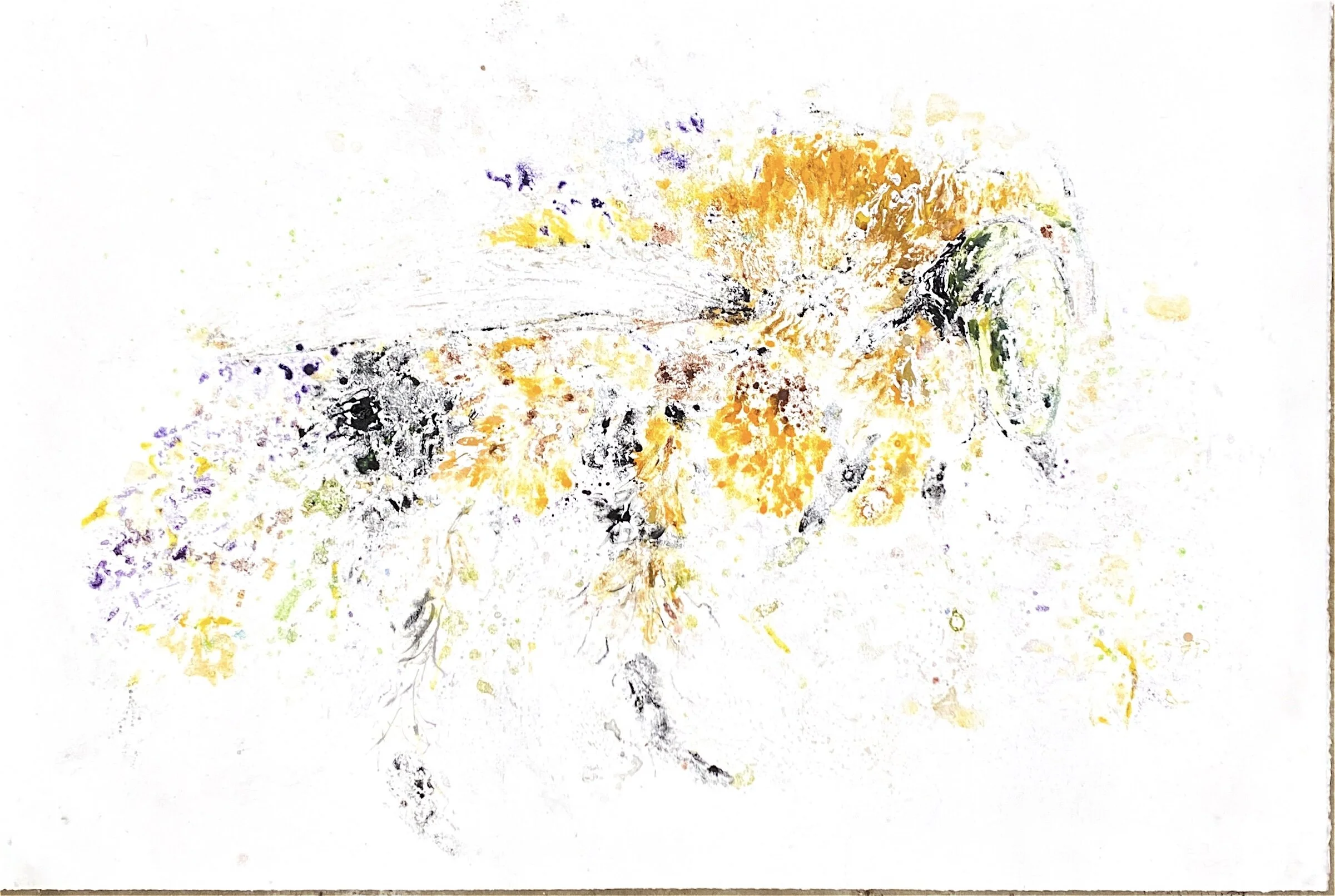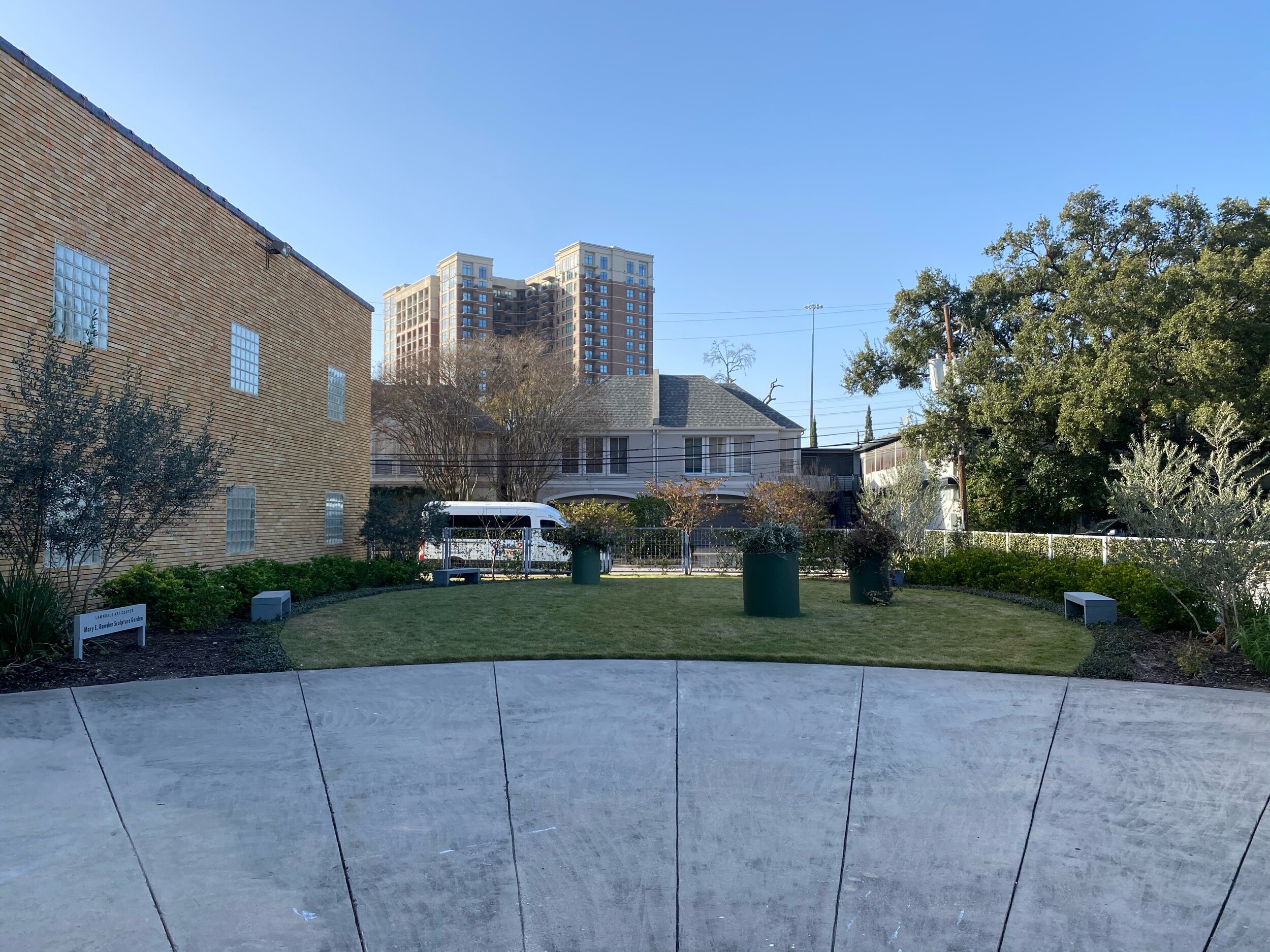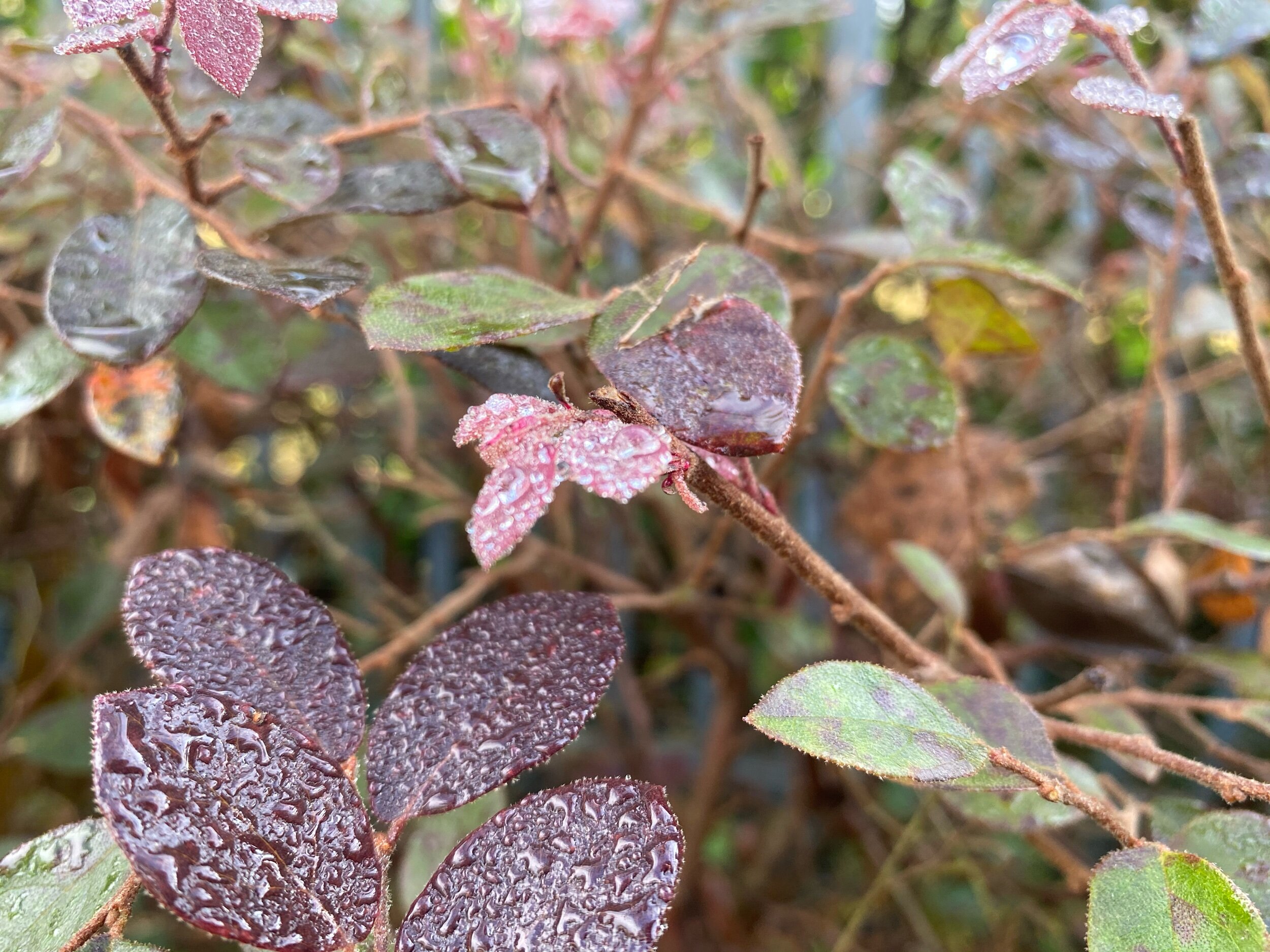Front legs and right shoulder
Endangered Knowledge: The Soul of Humus
20’ more of rebar.
I used 20’ more of rebar today to build the hip bones up on both sides and his right side in the stomach area of his side. I worked from the hip to his shoulder.
My work space is not large enough to get a good side photo.
Endangered Knowledge: The Soul of Humus
Stomach, upper hip bones, and more hump.
He still looks like a hybrid giraffe bison, that is only because his muscles and fur come later.
Endangered Knowledge: The Soul of Humus
Another big day of welding..I added a big 96” circumference chest. Put the entire piece on four dollies and started his hump. Below are a few pics from todays work.
Behind my garage is a telephone pole. I use it to bend my rebar. This is a side view where I am going to bend the piece for the chest.
Halfway to becoming a bison chest.
Then I use my weight to even out the shape.
I hang the chest over the back and decide if it is big enough.
Next I weld the ends together .
Recycling some old dollies from past work and deciding on the best plan. Balance and portability is the goal. The brown paper is the footprint of my bisons. Each leg is supported by a dollie.
Thanks to Curtis for getting me the plywood and helping me mount the beast. This is just for while I work on the sculpture and for transportation. It is not part of the work.
Just goofing around
My garage studio assistant is taking a sun break.
Starting to assemble the hump.
And that's a wrap.
Endangered Knowledge: The Soul of Humus
July 5th.
Attaching the head—
I welded just one connection from the neck to the head. As I assemble other parts of his body I will continue to evaluate the position of the head. I want him to be his reaching to the side searching for the next blades of grass within the reach of his massive head and tongue. With only one weld I can easily cut it off if I decide it is not in the right place or at the right angle. I do enjoy having a bobblehead bison in my garage for a while.
Building the girt—
I happened to have a circular scrap piece of rebar almost the right size. I created it years ago to be a round seat for a faux bois chair that was started and not finished. I turned it into the basis for the bison’s rear hip girth/stomach.
It is a little small, the small size gives me the flexibility to add to it exactly where I want it to protrude. As I get more elements worked out I will make it larger by adding the back hip bones that protrude. t is a lot easier to add pieces as I build him than to cut out pieces.
1 small tack world neck to head. Just to see where I want it.
Endangered knowledge: the Soul of Humus.
SMH fall of 2020 was canceled due to Covid 19 last July of 2020. I put a halt on welding my piece and focused on planning “Symbiosis.” “Symbiosis” is installed the Big Show is opened which provided a tremendous amount of traffic. I will still check on it every day, but I will spend most of my day building my piece for SMH 2021. Today I started where I left off. Below are images from last year's work and blog posts.
When I stopped in 2020 I had the hooves on steel plate bases and new where I wanted them to bare the weight.
Today I cut the rebar to form the lover part of the legs and grinded the tips. Tomorrow I weld.
Some of my notes from measuring Epics Bob the bison January of 2020.
My bison will be in motion not standing still.
The skull and upper jaw.
And lower jaw
4 pieces of rebar cut for each leg will provide the structure of the lower legs.
Endangered knowledge:The Soul of Humus
I dried some cosmos leaves to us as the coat of a sculpture that is in the works - Endangered knowledge: the Soul of Humus. The piece will be in the #sculpturemonthhouston 2021 exhibit. I started the armature during COVID for the SMH 2020 exhibit, which was postponed. The sculpture looks at the ecological history of the coastal prairie. This texture is perfect #cindeeklementart #endangeredknowledge #coastalprairie #tezasart #houstonart #bioart #environmentalart #cosmos #art #sculpture #bison
Same Time Next Year - A little something
A biological memento for Same Time Next Year
Normally I do not include fleshy or soft finds. I will break that tradition with this trinket of nature. I found this larva the first week of January 2021. It is in my freezer as I write. So that I don’t have to worry about it getting thrown away, I will put it in my 2020 nest. I am hopeful that I still have the Polytgemus Moth that I collected in fall September 2919 at my studio. The two together will spark a stronger connection to appreciate and protect urban wildlife.
The sidewalks in my neighborhood are my nature trail. I walk with my eyes on the prowl for intriguing insects, exoskeletons, insect wings, feathers, dried flowers, twigs, leaves, seeds, and pods — things my children’s eyes taught me to find during our walks together over the years. Since 2013, these biological mementos have found their way into my bronze work in the molds of nests. Each piece is a reflection of that year’s ecology and records the time and movement of environmental restoration…………n Dirt to Soil, Gabe Brown quotes Don Campbell, “If you want to make small changes, change how you do things, if you want to make big changes change how you see.” When I come across intriguing flora or fauna on my urban trail, albeit few and far between, I see them as evidence that can inspire a revolution in the landscape. If they are expired and will not decompose, I collect them. I see these bronze cast nests as urban wildlife fossils—biographies, every year a chapter recording Houston's environmental awakening……….
Below m are screenshots from my seek application that I use to identify species.
A screen shot from the app seek, a wonderful app for identifying species.
Fall 2019, I find- I think it is still in my studio in a Plastic cup.
Root to Water- when science backs your art -Art that looks at science with a critical eye.
"It is clear that the past offers a vast repertoire of cultural knowledge that we cannot ignore," highlights Professor Boivin.
It is a different way to think of things; however they are on the right root. I have a feeling there will be more areas Root to Water intersects science.
ROOT TO WATER
12” X 18” X 12”
found objects: rusted steel irrigation wheel, root
photo by Nash Bake
Spontaneity and art - a good thing, we will see
I started my day at 6:30 am, pasting images of work into a word document for a curator/art consultant. A necessary task that I was thrilled to do- however, mind-numbing, to say the least. By 12:30 crossed eyed I took the dogs on a walk. When I came across this. My mind numbing was instantly healed with inspirational thoughts.
Seven immaculately bundled trimmings from a neighbors Crape, Myrtle. Crape murdered or not I- the trees were in the backyard, could not see them.
My trimmings from a site-specific installation @Lawndale Center for the Arts. Symbiosis
The image above is from last week at Lawndale (a post in am tardy with) My trimmings are wild and unruly. I am using them on social media to make a point - to change how we landscape- to landscape with habitat for wildlife in mind.
My neighbor's bundles of limbs are in sharp contrast to mine. They are an example of how controlling urban green spaces have become, the tidiness that is expected In our yards.
I am so tempted——— Such a great opportunity to turn these found object organic materials, perfectly assembled tied up with yellow cords into gorilla art. The colors will look amazing at Lawndale. It is not part of my work on Symbiosis to install anything I want. 🤔 The entire dog walk I was haunted by the bundles and their yellow cords. I am not comfortable installing gorilla art but I am excited with the idea and I know Lawndale won’t have me arrested like other institutions might if I randomly installed objects in their sculpture garden, right?
I have always challenged myself to take on the art that scares me the most- to embrace the butterflies as my son tells me. You don’t know until you try. - jump
I went to the door, I was hoping no one was home, Abby was a new neighbor and I introduced myself. - she moved in during Covid. We had a nice chat and she welcomed me to take her piles.
It took two trips
😁 when I bring new materials to Lawndale, I like to photograph them on this turquoise wall- documenting my materials. And I have to say! I love the colors - the Textures.
I declare this installation number 1. Untitled.
This technically is not Lawndale property, the wall is theirs, but the lot is unfortunately not owned by the institution. The lot is vacant. I get all the bundles out so I can pick up load number 2.
Installation number 2
Installation number 3
The yellow ties make my heart sing, that rich brown against the turquoise, and the golden grass softening the base, I am in heaven. I see ballerinas chins up, lined up to take their bows center stage. I had one left.
A painter from last week left their yellow roller- waste not want not. The clippings Are rich on the violet too.
Sometimes I feel guilty that I love my work so much.
Rumblings - work in progress-
Neonicotinoids disturb bumble bee and flies sleep and ability to know when to forage. It is banned in the EU and not in the US. This isn’t enough, these products used in urban gardens harm bees. Articles like these inspire me to plug on.
I have lost count
artist statements are also works in progress
as it sits
RUMBLINGS
Artist statement
A rumbling in the distance is nature's way to alert living creatures to their environment.
Rumblings is a work in progress, a monumental collection of fifty 30" X 44" watercolor monotypes that draw attention to the endangered knowledge of the 20,000 species of wild bees.
In these works, I carefully manipulate watercolor ink, and solvent into a chaos of infinitely miniscule paint particles. The materials are interconnected across the over-size monotypes, paralleling the synergistic, aqueous effects of the untold bee species' magnetic attraction to golden dust and their corresponding fragility due to the applied chemicals that flood residential gardens and industrial agriculture. Closely studying their exceptional ability to buzz and pollinate with their exceptional pollen-adhering bodies, I use abstraction and zoom in to depict the organized mayhem of their movements.
The installation of Rumblings inspires curiosity, alerting all viewers to pay attention, asking them to consider the unintended consequences of their actions in our-interconnected micro ecosystems. It is a resounding call to decrease pesticide usage, provide habitats for nesting, and plant native indigenous plants providing nectar for the bees that are responsible for 70% of the foods we eat.
What I do not know is when and where they will be installed, when that is in the picture I may find ways to connect the pieces visually. That will have an impact on the statement. Until the plant beautiful native plants.
There are bees that have not been seen since the 60’s that are not listed as endangered.
After reading the document that listed Bombus Affinis as an endangered species I formed my own opinion by and it does not reflect well on the chemical industry.
Bombus Affinis - the rusty patch bumble bee
The bee that pollinates tomatoes is not the honeybee.
Summary from sciencedaily.com
The yield and quality of many crops benefit from pollination, but it isn't just honey bees that do this work: bumble bees also have a role. A team has used innovative molecular biological methods and traditional microscopy to investigate the pollen collecting behavior of honey bees and bumble bees in agricultural landscapes. It turns out bumble bees take much more pollen from different plant species than honey bees to satisfy their need for protein.
bumble bees are superior pollinators of tomatoes than the honey bee. The southern carpenter bee also pollinate tomatoes.
Turning back the evolutionary clock evolution in urban neighborhoods
4" X 13" X 8"
bronze
photo by Nash Baker
The sidewalks in my neighborhood are my nature trail. I walk with my eyes on the prowl for intriguing insects, exoskeletons, insect wings, feathers, dried flowers, twigs, leaves, seeds, and pods — things my children’s eyes taught me to find during our walks together over the years. Since 2013, these biological mementos have found their way into my bronze work in the molds of nests. Each piece is a reflection of that year’s ecology and records the time and movement of environmental restoration.
Initially, I was unaware of the landscape around me, but as my art dove deeper into environmental restoration and Hurricane Harvey changed our city, I realized that my days are, in fact, full of sterile surfaces. With COVID-19 quarantine, children in my neighborhood started venturing outside and looking for things to capture their curiosity. Delighted with their new interest, I realized that the green spaces and puddles children explore now are no longer filled with a diversity of life; the box turtles, bullfrogs, tadpoles, bumblebees, and assortments of flitting insects have evaporated with the spray of insecticides and herbicides in our neighborhoods. The selection is reduced to cicadas, the common beetle, honeybees, a rare native bee, and an abundance of Cuban lizards that dwell in turf grasses, boxwoods, crepe myrtles and oaks. I have awakened to cultural landscape uniformity. COVID has changed how I see the need for perfect lawns; the dirty truth is mosquito home-misting machines, obsessive weed control, artificial turf and a lack of plant diversity have turned urban neighborhoods into manicured monocultures for humans exploring video games. These habitat changes in massive population centers are fast-forwarding evolution: loss of wildlife habitat is one of the biggest threats facing many animal species. This does not have to be—it is a societal choice, the ability to speed up evolution can go both ways. Through my works – Lawndale’s Symbiosis, Endangered Knowledge: The Soul of Humus, Gust, World of Hum, Rumblings and Root to Water—I am committed to creating work that educates and helps communities change how we landscape our cities to include valuing the natural world and turning back evolution.
In Dirt to Soil, Gabe Brown quotes Don Campbell, “If you want to make small changes, change how you do things, if you want to make big changes change how you see.” When I come across intriguing flora or fauna on my urban trail, albeit few and far between, I see them as evidence that can inspire a revolution in the landscape. If they are expired and will not decompose, I collect them. I see these bronze cast nests as urban wildlife fossils—biographies, every year a chapter recording Houston's environmental awakening. As an optimist—environmental—art—activist my work focuses on revealing endangered knowledge to change how we see urban landscapes and activate cooling the planet through our cityscapes. As migratory birds return year after year to build nests and raise their young, I return with optimism in my step. I envision witnessing the return of four hundred plus butterfly species and eight hundred bee species native to Texas. I can see this returned wildlife capturing my future grandkids' imaginations. I will tell them the story of how insects almost disappeared and how every yard is a micro-ecosystem and matters. I imagine their hands building nests with a diversity that I cannot imagine. I hear their voices telling me in one breath about the fuzziest-biggest bee they ever saw, covered in golden dust nesting in a patch of ground beneath the sunflowers not far from the silverleaf nightshade. I see them bringing me a tail-feather from a Red Shoulder Hawk and asking, "what does it hunt" and is it the bird that sounds like the squirrel's screech. After a rain, I see them finding two bullfrogs attached and their tiny ribbons of floating eggs in a pond. I hear them tell me not to touch the caterpillar of the southern flannel moth, and asking me, “how does it sting?”. At the low of evening when dragonflies hover; I will watch as they study the night heron’s quiet solitary stance as it stalks small citizens of the grass, I will smile as they question the raucous warnings of ravens and the scoldings of nut collecting squirrels. I will feel their excitement when neighborhood raccoons appear from storm sewers and scavenge treats from dog bowls and opossums waddle fence lines, searching out grubs and open garage doors. I will follow their eyes when the silent patrol of the lone coyote visits the shadows of our boulevards from their bayou bound dens. I let them sleep outside and hear their heavy eyelids ask, why do the owls ask who? I listen as they wake up to a concert of white-winged doves. I will feel peace when they are wise to nature.
Lawndale Art Center - symbiosis
In a nutshell, this is what I hope to achieve with my site-specific piece, Symbiosis.
I am rethinking the uses of yard clippings.
Lawndale - Symbiosis - extractive
In Symbiosis I am stretching my practice and creating a living piece of site-specific art activism that will reimagine a 53.5’ X 48’ traditional urban landscape/sculpture garden and answer the question: how do we holistically restore an ecological balance in Houston? Symbiosis is a collaboration with Lawndale Art Center’s community, neighbors, urban wildlife, and the coastal prairies carbon cycle.
The west border of the garden has five 1 1/2 year old Crepe Myrtle’s a tree famous for murder. The murder refers to badly pruning the tree- down to the knuckles. I was not having these Crape Myrtle’s murdered. Today I used a extractive method of sculpting and clipped- nipped - and cut the existing branches. I shaped the branches/armature of the two end trees.
A sculpture garden has the four seasons of the year and a sculpture garden has the additional change of exhibitions. The pedestals from the last exhibit were still in the garden. 🤔perfect way to highlight the beauty in the wild- the imperfect- the not immaculate urban landscape.
FYI- crepe Myrtle’s are not native however they are a cherished gift to the Art Center. As an optimistic art activist I look at the project holistically to include the desires of the Art Centers board.
When I work in wire, or steele if I cut too much I can always weld it back it add more wire they are forgiving materials. When I clip a branch it is gone- no second chance. .
#artactivism #cindeeklementart #symbiosis #lawndaleartcenter #nativeplants #coastalprairie #sculpture
Create Myrtle cuttings wildly place on a pedestal.
North West Crepe Myrtle after pruning.
Cuttings from two Crepe Myrtle's and the olive trees from a few weeks ago.
South end Crepe Myrtle
Lawndale’s Symbiosis - constant research
Symbiosis is a long term art installation. A piece of dirt in the middle of a large US city, an ecosystem that serves the local art community. Through pairing my intuitive sculptural practice, and natural history research I am sculpting the garden into an ecosystem that balances the needs of the Homo sapien art community and the urban natural world. I spend much of my time filtering through biologist research, inspirational documentaries and interviews of individuals that are leading the way. New Year’s Day I listened to a remarkable podcast an interview of Nora Bateson who is an award-winning filmmaker, writer and educator, The podcast was taped before the pandemic. She knows what she is talking about. Here are two quotes from the podcast that gave me pause and reminded me how grateful I am for my opportunity to make a difference through Symbiosis at Lawndale
“ In my little fantasy there is a great big pause button, and we can say hold everything, let’s regroup, let's turn this titanic around”
“One way or another the systems that we are within are going to change.”
A very enlightening podcast regarding how change and regeneration happens. It is haunting to consider this came out before the Covid 19 quarantine of 2020. Everything Nora talks about addresses the things I am thinking about. She is most definitely an influencer. I will continue to follow and monitor her work.
You can find the interview at The Regenarration podcast on Soundcloud Solve Everything at once.
Checking on the garden I found a moth that was still alive laying in the Pond. I rescued him and laid him out to dry.
Subterraneous Secrets - how plant roots communicate with microorganisms
Lawndale symbiosis - milkweed and monarchs
I have read that a few migratory monarchs spend the winter in the Houston area and join a small resident population of monarchs. I have also read that it is essential to choose native milkweed as opposed to tropical. Tropical milkweed—doesn’t die back in the winter as native milkweed does. When a place to lay their eggs year-round is available, many monarchs don’t bother making the trip to Mexico.. I saw this caterpillar on my morning walk. It was seriously munching on the milkweed. Milkweed is the only plant that provides the nourishment that will transform the caterpillar into a monarch butterfly. It is important to plant only none-hybrid native milkweed. Texas milkweed will be included in my 2021 Lawndale Art Center Sculpture garden piece Symbiosis. In Symbiosis, I am stretching my practice and creating a living piece of site-specific art activism that will reimagine a 53.5’ X 48’ traditional urban landscape/sculpture garden and answer the question: how do we holistically restore an ecological balance in Houston? Symbols is a collaboration with Lawndale Art Center’s community, neighbors, urban wildlife, and the coastal prairies' carbon cycle. For more details see this link.
#carboncycle #cindeeklementart #texasart #houstonart #contemporaryart #modernart #caterpillar #monarch #milkweed #nativeplants #migration #energy #movement
#lawndaleartcenter #symbiosis #artactivism
The day after the caterpillar sighting.
The beauty of a leaf runs deep.
How beautiful droplets of dew or rainwater puddle on the waxy leaf surfaces? They provide the watering holes for nature’s tiniest creatures.🐞🐛🕸️🦎🐌🐸🐜🦋🐝
What do you see when you see a leaf? ☘️🌿🌱🍀
I see a unique natural system. Leaves multi-functioning as micro reservoirs, coats of armor protecting the soil, and micro floodgates slowing rainwater. 💦🌊💧
On the Coastal prairie, leaves function to protect the soil from being compacted by the pelting raindrops. If the heavy raindrops fall is not broken by layers of leaves and organic matter, the tiny cavities in living soil collapse, and rainwater moves horizontally across our landscape instead of into the tiny reservoirs in the soil. We need these small cavities to allow water to penetrate deep into the soil. Leaves also slow rain droplets giving the soil time to transport the rain to its deepest roots. Once the rain is in the ground cooling our planet leaves protect the soil from the heat of the day. This multilayered ground cover gives rain more time to trickle into the aquifer. Purifying our water and cooling our planet. How amazing are leaves? As an artist my how we see urban landscapes
My work records endangered knowledge to the collective memory and reimagines urban landscapes to holistically balance the needs of humanity and wildlife.
In Symbiosis I am stretching my practice and creating a living piece of site-specific art activism that will reimagine a 53.5’ X 48’ traditional urban landscape/sculpture garden and answer the question: how do we holistically restore an ecological balance in Houston? Symbiosis is a collaboration with Lawndale Art Center’s community, neighbors, urban wildlife, and the coastal prairies carbon cycle. #symbiosis #lawndaleartcenter #urbanlandscapes #artadia #coastalprairie #water #leaves #conservation art #bioart #nature #contemporaryart #modernart #artactivism #cindeeklementart #texasart #houstonart

